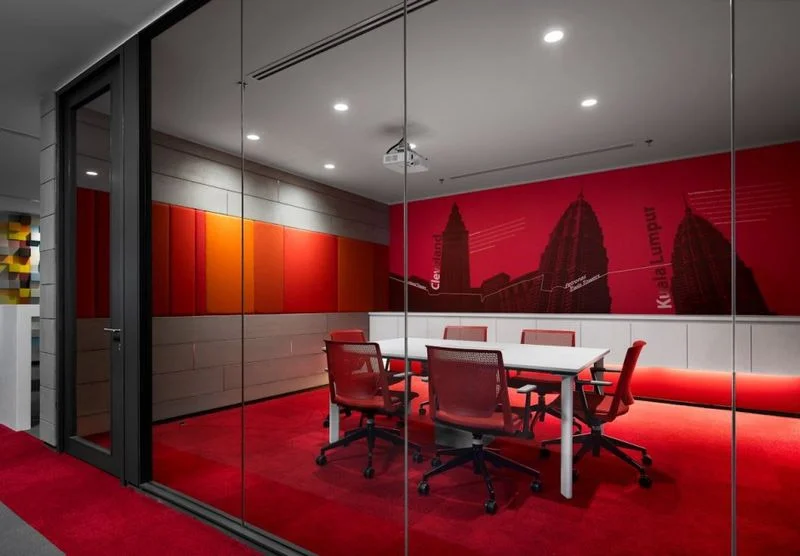After recent research studies by the University of Texas, there was a surprising revelation found regarding the colour of office walls and how the predominant colours can alter the atmosphere and general mood of employees. In this interesting report, the university realised that bland colours such as greys, beiges as well as whites actually caused feelings of depression and sadness in women. On the other end of the spectrum, men felt depressed and sad when working in environments that utilised colours in shades of orange or purple. Other scientific studies have found that colours are also responsible for things such as productivity at work.
Within this article, we take a look at five different ideas that can make your office a more vibrant and stimulating place to be, that will promote productivity and help with creativity and optimal performance within your workforce.
It is fascinating to think that colour has such an impact and influence on a persons behaviour and scientific research now proves this. This article is not aimed to explain the scientific or vast areas of psychological research studies, but rather the essentials that can be put into place and implemented by business owners.
1) Inspire & Motivate
When asked, colour psychologists reported that there are four main psychological colours and they are blue, red, green and yellow. Each of these colours have a specific effect on the mind as well as the body and soul. These four basic colours are the most powerful and they have different effects when combined with two or more. Understanding that colour does play an impact on psychology should be noted.
The ability of a colour to stimulate or soothe a person is based on how intense the colour is displayed and how saturated the environment is with that colour. You will want to find a colour that affects body, mind or emotions in a positive way. Secondly, you will want to find the correct brightness of the colour that works for your own productivity. Some colours that you choose may not be compatible with everyone, so be aware of this.

2) Reds
The colour red is a more productive and active colour. It can trigger things like typical “fight or flight” responses and brings about greater attention and focus in individuals. If the work environment is a physical job, this colour can increase production, whilst colours like blue and yellow would not be ideal for a physical workplace. Red is a colour that reinforces strength and stimulates the mind. If a person does not deal well within highly stressful situations, then this colour may actually reduce work productivity. If you have a physical job, then harness the power of red. This may explain why many successful sports teams tend to wear red jerseys.

3) Blues
Blue is a very popular colour for office spaces because it has the ability to calm the mind and helps with issues like concentration. This colour can do special things like enhancing wakefulness and brings about better and clearer communication between people. Blue is a mental based colour and can be great for offices and workplaces where thinking and creativity need to be amplified. Blue naturally increases creativity and intensive focus which is necessary for office working environments.

4) Yellows
This is an extremely vibrant and positive colour that intensifies energy and naturally brings about higher confidence levels in people. If you need to get into a happy and positive state of mind to produce high-quality work, be sure to use this colour in your workplace. It is the strongest psychological colour in the spectrum and it can help with stimulating creativity. It can also help with bringing about a more optimistic mental state and another secret is that it is an emotional colour.

5) Greens
Green, the only non-primary colour from our list of four, is very calming and is naturally balanced. It is a mix of other primary colours (blue and yellow) and instills a sense of calm, relaxation as well as reassurance. If you have a large amount of work that needs to be completed, you should harness this colour because it can boost your productivity. If you enjoy being balanced and in a more calm and relaxed state of mind, then green is the ideal colour for your environment. Living walls have become very popular in recent years, where living plants are grown vertically onto internal walls. This adds a huge splash of green as well as bringing real nature into what is usually considered an artificial environment.
Use colour for maximum results
A wide range of colours can either stimulate or soothe a person and this is a known fact. Understanding these key concepts will help to improve your working environment or even your home life, if chosen to be put into effect.
It’s important to note that the intensity and saturation of a colour will have varying effects on your body, mind and emotions, so getting the balance right is key. Knowing the right brightness levels and your individual needs will determine your colour choices and blending preferences you desire. What may work for you personally may not work with other employees. So be sure to choose the right colour for the right type of working environment, your staff demographics, their daily tasks and working habits. Any introduction of colours should be gradual. Monitors the net effect and then decide if you need to intensify the saturation levels of the colour so reduce them accordingly. It’s a learning process that will not only be fascination, but hugely rewarding.




